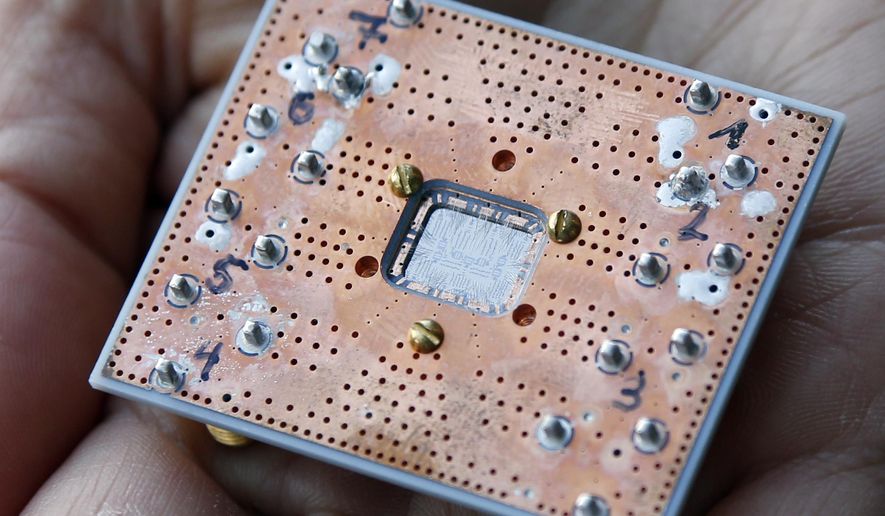A congressional panel is scrutinizing China’s quest for teleportation technology and its use of new quantum tools that can transfer information from one place to another without physically moving it.
The fledgling teleportation capability may not be able to beam people around the galaxy as in the science fiction show “Star Trek,” but the ability to move around tiny bits of information more efficiently may give Beijing a secure method one day to collect and transfer sensitive data. The prospect is provoking fresh questions about what exactly was inside the suspected Chinese spy balloon shot down after traveling across the U.S. last year.
In a hearing last week, the congressionally chartered U.S.-China Economic and Security Review Commission examined China’s efforts to transform its military by applying quantum and other emerging technologies.
“The Chinese do appear to have chosen that to be an area in which they want to excel globally, and one aspect of that is China has launched two different satellites that are capable of quantum communication from outer space, which includes quantum teleportation of individual particles mediated by satellite communication,” Rand Corp. physical scientist Edward Parker told the commission. “No other country is known to have launched quantum communication satellites.”
Quantum teleportation is made possible through the entanglement of two particles, such as photons, which form at the same instant and place and continue to share a mutual existence when separated by large distances, according to MIT Technology Review. Information downloaded to the photon in one spot would theoretically be transmitted via an entangled link to the photon in another spot.
In 2020, the National Science Foundation funded research showing teleportation may be possible in electrons and photons. That same year, scientists at Fermilab and the California Institute of Technology said they teleported “qubits,” or quantum bits of information, over 27 miles using state-of-the-art photon detectors and off-the-shelf equipment.
A team of Chinese scientists claimed in 2017 to have teleported photon qubits from a ground observatory to a low-Earth-orbit satellite through an uplink channel over distances up to 870 miles. To overcome atmospheric turbulence in the uplink, the team said, it developed techniques such as a high-bandwidth and high-accuracy acquiring, pointing and tracking system.
The implications of teleporting data are immense as military and intelligence services seek secure communications platforms that extend beyond the reach of their enemies.
China’s interest in quantum technology intensified after former National Security Agency contractor Edward Snowden allegedly revealed details of U.S. intelligence capabilities and activities, according to a 2018 study by the Center for a New American Security.
Balloon-watching
China’s reported successful application in outer space has raised questions about whether quantum technology can be deployed in devices traveling across high altitudes within Earth’s atmosphere, such as the suspected surveillance balloon that flew across the U.S. last year and sparked a significant meltdown in U.S.-China relations.
U.S.-China Economic and Security Review Commissioner Jacob Helberg questioned Mr. Parker about the applicability of quantum technology inside enemy spy balloons.
“If you hypothetically attached a quantum sensor to a giant helium balloon that you flew over, in a guided way, over our nuclear silos, wouldn’t that allow revealing sensitive national security information about our nuclear silos?” Mr. Helberg asked. The Rand researcher said he had not “looked into that question in enough technical detail to comment.”
Mr. Helberg told The Washington Times that details about the downed balloon remain classified and he has concerns that quantum sensors on such balloons can enable an adversary to conduct subterranean mapping and other surveillance.
Whether the suspected spy balloon carried quantum technology is not publicly known, but it reportedly used an American internet service provider as it traversed the country. China said the craft was a weather balloon blown off course and sharply criticized the Biden administration’s decision to shoot it down.
Maj. Gen. Patrick Ryder, a Pentagon spokesman, said in June that the U.S. government assessed the balloon had intelligence-collection capabilities but did not collect information while transiting the U.S. Gen. Ryder said the U.S. government took steps to limit the balloon’s potential collection efforts.
According to an NBC report in December, the intelligence community determined that the balloon sent and received communications from China and could send high-bandwidth data collections over short periods.
The NSA declined to answer The Times’ questions regarding its understanding of quantum teleportation technology and whether it knew about such use in the downed balloon. The Office of the Director of National Intelligence declined to comment on whether the balloon contained quantum technology.
The NSA said some quantum technology is not ready to secure national security data. The agency says on its website that it does not support the use of quantum key distribution (QKD) and quantum cryptography (QC) to protect national security systems and does not anticipate approving the use of the technology by collaborating entities.
“Communications needs and security requirements physically conflict in the use of QKD/QC, and the engineering required to balance these fundamental issues has extremely low tolerance for error,” the NSA’s website said. “Thus, security of QKD and QC is highly implementation-dependent rather than assured by laws of physics.”
Whether the perceived insecurity of quantum technologies made the suspected spy balloon vulnerable to the U.S. intelligence community’s signals collection capabilities is unknown. The Biden administration sought a Foreign Intelligence Surveillance Court order to collect intelligence on the balloon as it flew over America, according to NBC.
The bottom line is that teleporting information is complex and teleporting humans is likely to remain in the realm of science fiction for a long time, Mr. Parker told the congressional China panel.
“Just one last technical note: Teleportation certainly does not allow teleportation of humans or significant quantities of material,” Mr. Parker told lawmakers. “It’s individual particles.”
Commissioner Randall G. Schriver suggested an edit to Mr. Parker’s note.
“Dr. Parker, I think you forgot to end your sentence with ‘yet,’” Mr. Schriver said to laughter.
• Ryan Lovelace can be reached at rlovelace@washingtontimes.com.




Please read our comment policy before commenting.